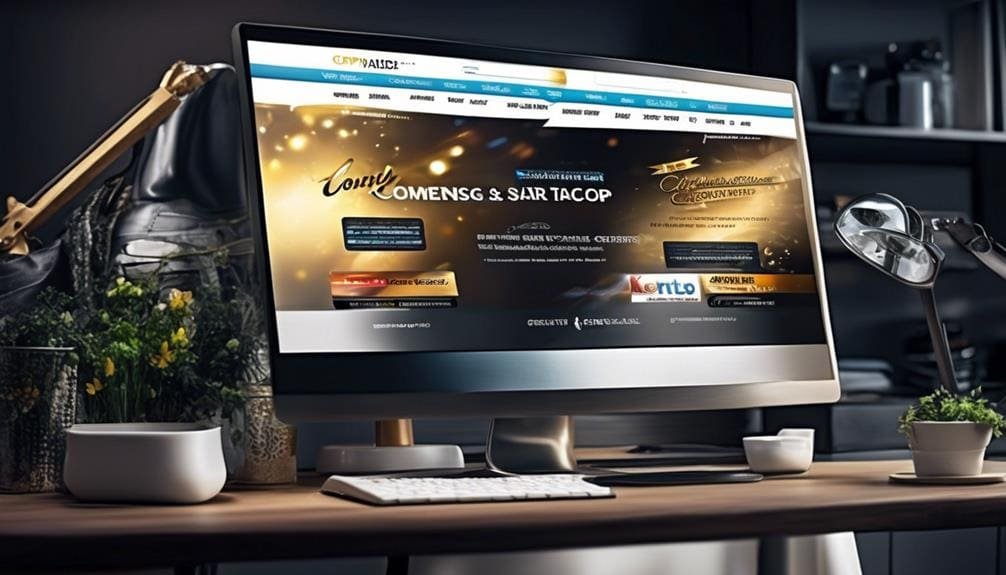5 Best Tips for Customized SEO Title Tags
February 25, 2024 | by Jacob Cavazos

As we navigate the ever-evolving landscape of SEO, crafting customized title tags is akin to selecting the perfect outfit for a high-profile event; it requires attention to detail and strategic choices. Our team has delved into extensive data to uncover the five best tips for optimizing SEO title tags. From integrating relevant keywords to crafting concise and compelling descriptions, these tips are essential for driving organic traffic and boosting search engine visibility. But there's a crucial aspect that often gets overlooked, and it could be the key to unlocking higher click-through rates.
Crafting Unique Title Tags
Crafting unique title tags plays a pivotal role in enhancing search visibility and attracting potential users to our webpages. Effective title tags are essential for SEO ranking factors and can significantly impact a webpage's performance in search results. When crafting title tags for SEO, it is crucial to incorporate the target keyword at the beginning of the tag and within the recommended character limit of 60-70 characters. Our best practices emphasize the importance of creating descriptive and engaging title tags that accurately represent the content of the webpage. By utilizing compelling language and catering to user intent, we can improve click-through rates and ultimately enhance our website's visibility.
In addition, crafting unique title tags helps avoid keyword cannibalization and ensures that each webpage has a distinct and targeted title tag aligned with specific topics and keywords. Leveraging SEO plugins such as AIOSEO can streamline the process of generating and optimizing title tags, aligning with best practices and saving time. By following these tips for writing meta titles, we can maximize the impact of our title tags and improve the overall performance of our webpages in search results.
Optimizing Title Tags for Keywords
Optimizing title tags for keywords involves strategically placing the main keyword close to the beginning of the title tag, ensuring it aligns with our SEO efforts to enhance search visibility and attract potential users to our webpages. By including your target keyword near the front of the title tag, you signal to search engines the primary focus of the page. This optimization can improve the page's relevance and potential ranking for that keyword in search engine results. It's important to make sure that the title tag accurately reflects the content of the page while incorporating the primary keyword. Google Search Console provides insights into how Google interprets and rewrites title tags, offering valuable feedback on the optimization of your titles.
When optimizing title tags for keywords, keep the character limit in mind to ensure that the full title displays properly in search results. Craft a descriptive and compelling title tag that accurately represents the content and entices users to click. Avoid keyword stuffing and prioritize relevance to the page's content when optimizing title tags. Utilize separators like '|' to save pixel space and make the title tag visually appealing. By optimizing the title tag to better reflect the content and include the primary keyword, you can enhance the page's visibility and click-through rate.
Writing Compelling Title Tag Copy

We believe in using specific and descriptive language to craft compelling title tag copy that increases clickthrough rates. When writing title tags for SEO optimization, it's essential to create compelling titles that not only incorporate relevant keywords but also entice users to click through to the web page. Compelling title tags are crucial for attracting attention from search engine result pages and standing out amongst competitors. By utilizing curiosity-inducing techniques, such as posing questions or hinting at valuable information, we can increase the likelihood of users clicking on our web page. Additionally, incorporating unique selling points, numbers, dates, and brand names can further enhance the appeal of the title tag. It's important to remember that while optimizing for search engines is vital, the primary focus should be on creating titles that resonate with human users. Keeping the title tags short, relevant, and to the point is key to driving organic traffic. By paying attention to word order, word limit, and conducting thorough keyword research, we can craft compelling title tags that effectively communicate the value of the content and encourage clickthroughs.
Catering to Search Intent
Understanding the search intent behind user queries seamlessly guides the transition from writing compelling title tag copy to catering to the specific needs and preferences of our audience. Catering to search intent is crucial for optimizing title tags for SEO and improving the overall user experience on a website. Here are four key strategies for catering to search intent:
- Aligning with User's Search Intent: Crafting title tags that align with the user's search intent is essential for increasing relevance and attracting the right audience.
- Using Relevant Language and Keywords: Incorporating language and keywords in the title tag that resonate with the user's search intent can significantly improve click-through rates.
- Addressing User Queries Effectively: Analyzing the user's search intent is crucial for creating title tags that effectively address their queries and provide valuable information.
- Enhancing Engagement and Satisfaction: Catering to search intent involves creating title tags that directly address the user's query, leading to better engagement and user satisfaction.
Encouraging Clicks With Curiosity

Encouraging clicks with curiosity involves crafting title tags that evoke intrigue and anticipation, prompting users to engage with the content for more information. By using compelling phrases and curiosity-inducing techniques, such as posing questions or incorporating elements of surprise, brands can increase the chances of users clicking on the link. Leveraging curiosity in SEO title tags can lead to higher click-through rates (CTR) and ultimately drive more organic traffic to the website.
When crafting SEO title tags, it's essential to incorporate the brand name and utilize the SEO plugin to optimize the Google title and meta descriptions. Including a strong call to action in the title tag can also encourage users to click on the link. Experimenting with different approaches to spark curiosity in the title tags can differentiate the content and attract more clicks. Research shows that creating a sense of mystery or anticipation in title tags can significantly impact user engagement and lead to a higher CTR, making it a crucial aspect of an effective SEO strategy.
Frequently Asked Questions
How Do I Optimize Title Tags for Seo?
To optimize title tags for SEO, we prioritize keyword placement, adhere to length limits, include our brand, and analyze competitors. Understanding user intent and local optimization, we also focus on mobile and voice search, and conduct A/B testing for effectiveness.
What Is the Best Strategy When Creating Quality Title Tags?
When creating quality title tags, we prioritize keyword placement, brand inclusion, and relevance to our target audience. We consider length, conduct competitor analysis, and align with user intent. Mobile optimization, A/B testing, and meta description alignment impact click-through rates.
Which of the Following Are Best Practices to Optimize a Title Tag for Seo?
Keyword placement, title length, brand inclusion, click-worthy language, target audience, competitor analysis, mobile optimization, meta description alignment, A/B testing, and search intent understanding are crucial for optimized title tags. It's imperative for SEO success.
How Do You Write a Perfect Title Tag?
We write perfect title tags by strategically placing keywords, adhering to length guidelines, including our brand, considering our target audience, analyzing competitors, crafting a compelling call to action, optimizing for mobile, local SEO, visual appeal, and conducting A/B testing.
RELATED POSTS
View all



